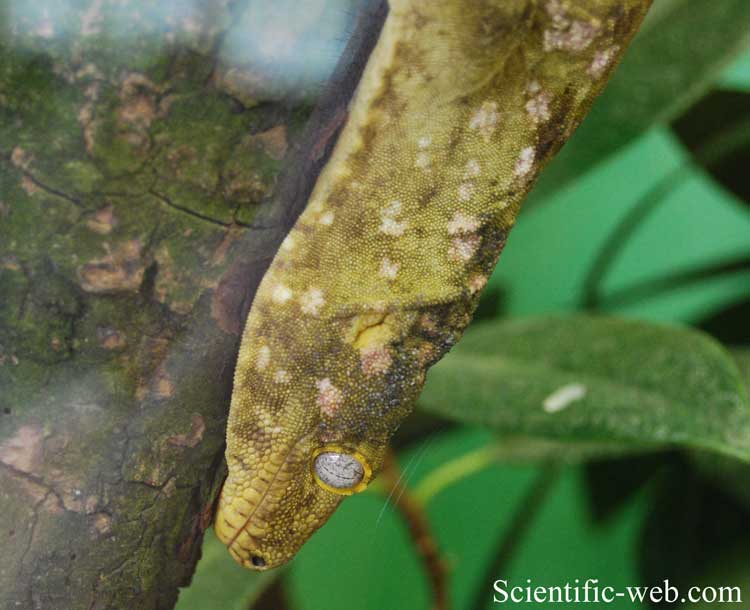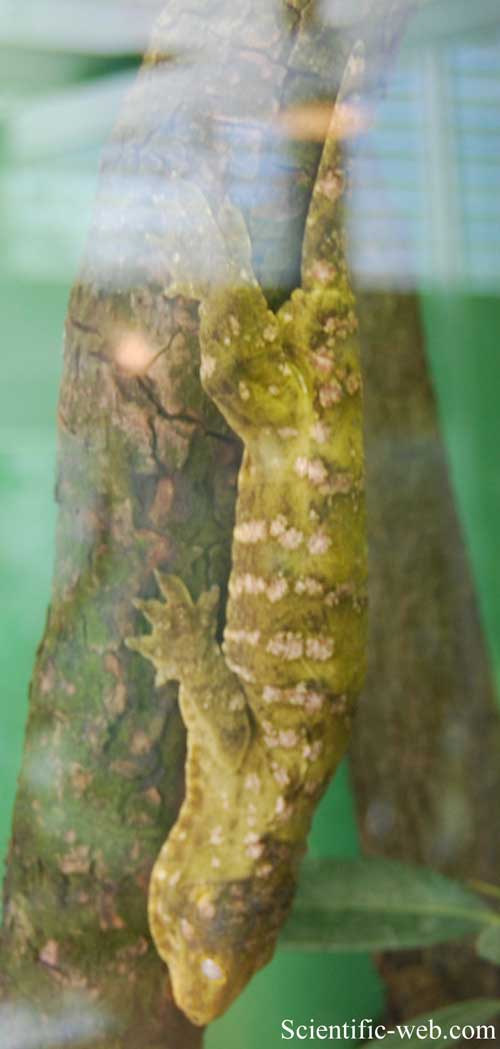
Rhacodactylus leachianus , Photo: Michael Lahanas
Superregnum: Eukaryota
Regnum: Animalia
Subregnum: Eumetazoa
Cladus: Bilateria
Cladus: Nephrozoa
Superphylum: Deuterostomia
Phylum: Chordata
Cladus: Craniata
Subphylum: Vertebrata
Infraphylum: Gnathostomata
Superclassis: Tetrapoda
Cladus: Reptiliomorpha
Cladus: Amniota
Classis: Reptilia
Cladus: Eureptilia
Cladus: Romeriida
Subclassis: Diapsida
Cladus: Sauria
Infraclassis: Lepidosauromorpha
Superordo: Lepidosauria
Ordo: Squamata
Subordo: Gekkota
Infraordo: Gekkomorpha
Superfamilia: Gekkonoidea
Familia: Gekkonidae
Subfamilia: Diplodactylinae
Genus: Rhacodactylus
Species: R. leachianus
Subspecies: R. l. aubrianus - R. l. henkeli - R. l. leachianus
Name
Rhacodactylus leachianus Cuvier, 1829
Vernacular names
English: New Caledonian Giant Gecko
日本語: ツギオミカドヤモリ

Rhacodactylus leachianus, Photo: Michael Lahanas
Rhacodactylus leachianus, commonly known as the New Caledonian giant gecko or Leach's giant gecko or colloquially Leachie, is a large species of gecko in the family Diplodactylidae. The species, which was first described by Georges Cuvier in 1829, is endemic to New Caledonia.
Taxonomy
The specific name, leachianus, is in honor of English zoologist William Elford Leach.[3] Historically, there have been three recognized subspecies of R. leachianus (including the nominotypical subspecies): R. l. aubrianus, R. l. henkeli (first described by Seipp and Obst in 1994), and R. l. leachianus. However, based on recent molecular data, no populations of R. leachianus are granted subspecies status at the present time.[1][4]
Description
Close-up of the New Caledonian giant gecko
At 14 inches (360 mm) total length (including tail), R. leachianus is the largest extant gecko in the world[5] and is considered an example of island gigantism. It has a heavy body, loose skin, and a small, stumpy tail. It is variable in color, coming in shades of mottled green, gray, and brown.[6]
Distribution and habitat
R. leachianus is found in all of the southern and eastern portions of the main island of New Caledonia, as well as on several of the smaller islands in the group.
Biology
R. leachianus is an arboreal species, living in trees. It is nocturnally active, but may bask in the morning sun.[6] It eats a diet of insects, spiders, small vertebrates, fruit, nectar, and sap.[6] Adult females of R. leachianus lay two eggs at a time, having up to 10 clutches per year.[6] R. leachianus can make a loud growling noise, and local people call it "the devil in the trees".[6]
Like many chameleons, New Caledonian Geckos can change the color of their skin. This is due to pigment containing cells called chromatophores. Depending on the amount of sunlight, their skin may be lighter or darker. This is a form of mimicry and can help the gecko blend into their environments. These giant geckos also can climb vertically up glass surfaces. This is due to adhesive pads on their feet called lamellas, which are made up of tiny hairs which increase friction force when applied to surfaces.[7]
Folklore
Some of the indigenous Kanak people of New Caledonia fear Leach's giant gecko. This is because of an old superstition which purports that it has the ability to cling to a person's body and pull out that person's soul. [8]
Conservation status
Populations of the species R. leachianus have likely been reduced by habitat destruction and degradation. This process is still a threat to the species. It also faces predation by introduced species such as cats and various rodents. It is also poached. It can be electrocuted when it travels along power lines. This species is protected and it lives in several nature reserves.[1]
In captivity
The New Caledonian giant gecko is occasionally kept as a pet. Individuals in the pet trade are propagated with captive breeding; wild populations are protected. This species may live over 20 years in captivity.[9]
References
Sadlier, R.A.; Bauer, A.M.; Jourdan , H.; Astrongatt, S.; Deuss, M.; Duval, T.; Bourguet, E.; McCoy, S.; Bouteiller, A.; Lagrange, A. (2021). "Rhacodactylus leachianus". IUCN Red List of Threatened Species. 2021: e.T176166A123252801. doi:10.2305/IUCN.UK.2021-2.RLTS.T176166A123252801.en. Retrieved 18 November 2021.
Rhacodactylus leachianus. The Reptile Database. www.reptile-database.org.
Beolens, Bo; Watkins, Michael; Grayson, Michael (2011). The Eponym Dictionary of Reptiles. Baltimore: Johns Hopkins University Press. xiii + 296 pp. ISBN 978-1-4214-0135-5. (Rhacodactyus leachianus, p. 153).
Bauer AM, Jackman TR, Sadlier RA, Whitaker AH (2012). "Revision of the giant geckos of New Caledonia (Reptilia: Diplodactylidae: Rhacodactylus)". Zootaxa 3404: 1-52.
Ballance, Allison; Morris, Rod (2003). Island Magic; Wildlife of the South Seas. David Bateman Publishing.
Rhacodactylus leachianus. Australian Reptile Park.
Sian Rutland, C., Cigler, P., & Kubale, V. (2019). Reptilian skin and its special Histological structures. Veterinary Anatomy and Physiology. doi:10.5772/intechopen.84212
https://www.youtube.com/watch?v=0FJNE4V7aPI LEACHIANUS GECKOS IN THE WILD, PART 1! | Rhacodactylus leachianus | (New Caledonia, 2018)
Guide to the Largest Geckos in the World. Stephen Cemelli.
Retrieved from "http://en.wikipedia.org/"
All text is available under the terms of the GNU Free Documentation License

